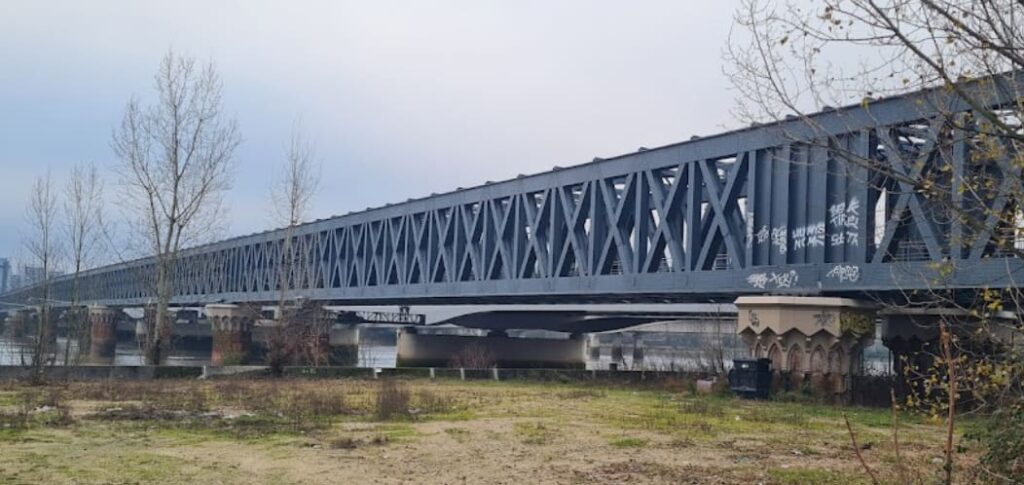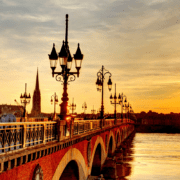
Passerelle Eiffel: the historic footbridge with an industrial charm in Bordeaux
The Passerelle Eiffel in Bordeaux is a testament to 19th-century engineering that continues to captivate locals and visitors alike. Its imposing iron structure, which rises above the Garonne River, invites you to discover its history and enjoy a privileged view of the city.
What’s more, this footbridge is very close to other points of interest that you can discover on our free tour of Bordeaux. In the meantime, we’ll tell you everything you need to know about this architectural gem that marked the beginning of the brilliant career of the famous engineer Gustave Eiffel.
What is the Passerelle Eiffel in Bordeaux?
This old railway bridge, also known as the Passerelle Saint-Jean, crosses the Garonne River and stands out for its industrial-style metal design. It was built with the intention of linking the railway networks of two important 19th-century companies. Its structure makes it a point of interest for lovers of architecture and history.
Today, the Passerelle Eiffel is a pedestrianised space where you can enjoy exceptional panoramic views of Bordeaux. If you are wondering what to see in Bordeaux in 4 days, we recommend you include this site, as it will give you some of the best views of the city.
History and evolution of the Passerelle Eiffel
The history of this footbridge dates back to 1858, when Stanislas de la Laroche-Tolay conceived the project. A young Gustave Eiffel, only 26 years old, took over the supervision of the work. His talent shone through in the management of supplies and in the direction of the works.
The official inauguration took place on 25 August 1860, after exhaustive load tests. For more than a century, this structure connected the networks of two important railway companies: the Compagnie des Chemins de Fer du Midi and the Compagnie du Chemin de Fer de Paris à Orléans.
In 2008, a new railway viaduct took over rail traffic. The original structure was recognised as a historic monument in 2010, preventing its demolition. After careful restoration between 2018 and 2020, it was reborn as a pedestrian space within the Euratlantique project.
Why visit the Passerelle Eiffel?
Walking along this footbridge means travelling through a piece of the history of Bordeaux. Its iron structure, a testament to 19th-century technical skill, laid the foundations for Eiffel’s future works. If you are interested in architecture or railway history, this footbridge will offer you a unique perspective on the evolution of transportation.
The footbridge has also become a key point for pedestrians and cyclists, with an exceptional panoramic view of the historic centre. The combination of iron with the urban and river landscape creates a picture worthy of a photograph.
How do you get to the Passerelle Eiffel in Bordeaux?
Located in the La Bastide district of Bordeaux, this footbridge crosses the Garonne River, next to the Saint John Bridge (Pont Saint-Jean). It is easy and accessible by public transport.
- Train: Gare Bordeaux Saint-Jean station is only a 5-minute walk away.
- Light rail: tram line D stops at Tauzia, about an 8-minute walk away.
- By bus: lines 20, 25, 31, 470 and 60 all stop nearby. The closest stops are Pont Saint Jean and Belvédère, about a 7-minute walk away.
If you arrive by train, follow the signs to the river and you will see the footbridge easily. If you want to plan your visit better, use transport apps to check up-to-date timetables.
What to see near the Passerelle Eiffel?
Make the most of your visit to discover some of the city’s most iconic places.
- Saint-Jean Bridge (Pont Saint-Jean): adjacent to the Eiffel Footbridge, this modern bridge connects the two banks of the Garonne River and offers picturesque views of the surrounding landscape. It is an ideal spot to admire the fusion of the old town of Bordeaux and its contemporary side.
- Bordeaux Stone Bridge: built in 1822, it was the first bridge to connect both banks of the river. Its structure of 17 arches of limestone and brick extends over 487 metres. It is a key work in the urban history of Bordeaux and an essential point for touring the city on foot or by bicycle.
- Place Stalingrad in Bordeaux: a dynamic space with terraces, green areas and the famous sculpture of the Blue Lion. It is a meeting point for locals and tourists looking to relax after a stroll along the banks of the Garonne. In the surrounding area, there are cafés and restaurants offering a wide range of cuisine.
- Basilica of St Michel of Bordeaux: a Gothic temple with a free-standing bell tower 114 metres high. Inside, it houses impressive 16th-century stained glass windows and a monumental organ. The square surrounding the basilica is a vibrant spot, with traditional markets and cultural activities throughout the year.
Interesting facts and figures about the Passerelle Eiffel
The Eiffel Footbridge also stands out for the many stories and details surrounding it. If you want to discover little-known facts, you’ll love exploring the curiosities of Bordeaux, where this iconic structure occupies a special place.
- Innovative material: puddled iron marked a before and after in 19th-century industrial architecture.
- Pioneering technique: the compressed air foundation in the tubular pillars laid the foundations for the future Eiffel Tower.
- Impressive dimensions: at 509.69 metres long and 8.60 metres wide, it is one of the largest footbridges in France.
- A heroic act: during the construction work, Gustave Eiffel himself jumped into the Garonne river to save the life of one of his workers.
- Adaptation required: on the last section of the railway line, trains were limited to a maximum speed of 30 km/h. The aim of this measure was to preserve the structure.
- Double identity: the people of Bordeaux know it as both the Eiffel Footbridge and the Saint-Jean Footbridge.
- Cultural recognition: its declaration as a historical monument in 2010 guaranteed its conservation for future generations.
In addition to being an impressive feat of engineering, the Passerelle Eiffel in Bordeaux is a testament to the legacy of Gustave Eiffel. Today, converted into a pedestrian bridge, it offers a unique experience for those who wish to explore Bordeaux from a different perspective. If you visit the city, don’t hesitate to walk along this historic footbridge and discover its industrial charm.
References:
- Around Us. (2024, November 20). Eiffel Footbridge. Available at: https:// es.aroundus.com/p/7394485-passerelle-eiffel
- Mairie de Bordeaux. (n.d.). From one bank to the other. Eiffel Bridge. Available at: https:// m.bordeaux.fr/es/passerelle-eiffel
- TRIPOMATIC. (n.d.). Eiffel Footbridge. Available at: https:// tripomatic.com/es/poi/pasarela-eiffel-poi:15053093



